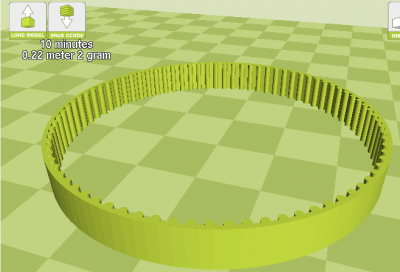3D Printed GT2 Belts: Difference between revisions
Jump to navigation
Jump to search
(Created page with "=Files= *https://www.thingiverse.com/thing:165792 *Seems to work: <html><iframe width="560" height="315" src="https://www.youtube.com/embed/lEON9Oi89L8" frameborder="0" allow...") |
|||
| (14 intermediate revisions by 2 users not shown) | |||
| Line 1: | Line 1: | ||
=Basics= | |||
*This page goes over the use of FDM 3D Printers to produce [[GT2 Belts]] | |||
*This would allow the [[Universal Axis]] to be all OSE made minus the rods and screws | |||
*Need to check the accuracy of the "teeth" being printed, and the strength of the weld if a segment joining method is used | |||
*Perhaps use a smaller diameter nozzle? | |||
=Print Methods= | |||
==Flat Method== | |||
*It would be printed flat in a strip or strips and merged together once done | |||
*Has the advantage of being perhaps more accurate/less likely to fail? | |||
==Vertical Loop Method== | |||
*Printed in one peice in a circular loop | |||
*Has the advantage of not requiring post print welding | |||
*Has the disadvantage of limiting size to the largest circle withing the print bed | |||
[[File:beltgt2.png|400px]] | |||
==Vertical Snake== | |||
*Prints a snaking ribbon with the thin edge contacting the print bed | |||
*Hybrid of the flat and vertical methods | |||
*Requires post merging, but maximises printable amount | |||
==Conveyor Belt Printer== | |||
*With one of these, the belt could be printed near continously and cut + fused when needed | |||
=Download= | |||
*'''Belt in OpenSCAD with customizer - https://www.thingiverse.com/thing:1975381''' | |||
=Section Fusing Methods= | |||
==Hot Plate Welding== | |||
*Did some research and this is supposedly the technical industry name for this process | |||
*For OSE Use perhaps a soldering iron on low, and a custom toolhead (flat metal rectangle slightly more wide than the belt?) | |||
==Ultrasonic Welding== | |||
*More complex | |||
*Advantages may not apply here? | |||
=Files= | =Files= | ||
*https://www.thingiverse.com/thing:165792 | *https://www.thingiverse.com/thing:165792 | ||
| Line 4: | Line 42: | ||
<html><iframe width="560" height="315" src="https://www.youtube.com/embed/lEON9Oi89L8" frameborder="0" allow="accelerometer; autoplay; encrypted-media; gyroscope; picture-in-picture" allowfullscreen></iframe></html> | <html><iframe width="560" height="315" src="https://www.youtube.com/embed/lEON9Oi89L8" frameborder="0" allow="accelerometer; autoplay; encrypted-media; gyroscope; picture-in-picture" allowfullscreen></iframe></html> | ||
=Cost Analysis= | |||
At 2 grams/6 inch - or 10 grams per 30" of the D3D Pro 8" bed - This makes 50 g for 5 axes (12.5 feet), or $1.5 belt cost with $30/kg filament. Compare to $5 for 30'. Price is about 1/2 as much for the 3D printed version using COTS filament, and much cheaper once own filament is made. | |||
=Internal Links= | |||
*[[GT2 Belts]] | |||
*[[Universal Axis]] | |||
*[[Mostly 3D Printed]] | |||
*[[Reprap]] | |||
*[[3D Printed Belts]] - clothing. | |||
=External Links= | |||
*articles on this? | |||
[[Category:Reprap]] [[Category:Belts Gears and Pulleys ? idk | |||
Latest revision as of 01:34, 1 June 2020
Basics
- This page goes over the use of FDM 3D Printers to produce GT2 Belts
- This would allow the Universal Axis to be all OSE made minus the rods and screws
- Need to check the accuracy of the "teeth" being printed, and the strength of the weld if a segment joining method is used
- Perhaps use a smaller diameter nozzle?
Print Methods
Flat Method
- It would be printed flat in a strip or strips and merged together once done
- Has the advantage of being perhaps more accurate/less likely to fail?
Vertical Loop Method
- Printed in one peice in a circular loop
- Has the advantage of not requiring post print welding
- Has the disadvantage of limiting size to the largest circle withing the print bed
Vertical Snake
- Prints a snaking ribbon with the thin edge contacting the print bed
- Hybrid of the flat and vertical methods
- Requires post merging, but maximises printable amount
Conveyor Belt Printer
- With one of these, the belt could be printed near continously and cut + fused when needed
Download
- Belt in OpenSCAD with customizer - https://www.thingiverse.com/thing:1975381
Section Fusing Methods
Hot Plate Welding
- Did some research and this is supposedly the technical industry name for this process
- For OSE Use perhaps a soldering iron on low, and a custom toolhead (flat metal rectangle slightly more wide than the belt?)
Ultrasonic Welding
- More complex
- Advantages may not apply here?
Files
- https://www.thingiverse.com/thing:165792
- Seems to work:
Cost Analysis
At 2 grams/6 inch - or 10 grams per 30" of the D3D Pro 8" bed - This makes 50 g for 5 axes (12.5 feet), or $1.5 belt cost with $30/kg filament. Compare to $5 for 30'. Price is about 1/2 as much for the 3D printed version using COTS filament, and much cheaper once own filament is made.
Internal Links
- GT2 Belts
- Universal Axis
- Mostly 3D Printed
- Reprap
- 3D Printed Belts - clothing.
External Links
- articles on this? [[Category:Belts Gears and Pulleys ? idk
